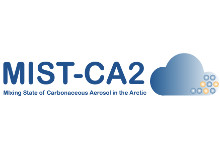Summary
Climate relevant properties of carbonaceous aerosol, as well as its residence time and deposition on snow and ice, are controlled by its mixing state. The lack of information on the carbonaceous aerosol mixing state limits our ability to predict the effective magnitude of the aerosol climate impacts. This project aims at investigating functional group composition of carbon-containing particles at the Zeppelin Observatory, and eventually compare the results with observations performed at the lower altitude site of Gruvebadet, using Scanning Transmission X-ray Microscopy coupled with Near Edge X-ray Absorption Fine Structure (STXM-NEXAFS). The location of the observatory (at about 500 m a.s.l) and the availability of a Counter Flow Virtual Impactor (CVI) will allow us to samples aerosol particles inside and outside clouds, and thus to investigate the impact of cloud processing on the aerosol mixing state and the functional group composition of carbon-containing particles.
Objectives
The objective of this study is to investigate the mixing state of carbonaceous aerosol particles at Zeppelin Observatory. Specific objectives include:
• identification of the functional groups of organic aerosol coating/inclusions in soot and inorganic particles;
• to investigate the effect of cloud scavenging/ processing on the composition of organic aerosol coatings and inclusions.
Project Partners
• CNR - ISAC
Other informations
This project is run in collaboration with Stockholm University and Norwegian Polar Institute







 Title: Quantification of the Mixing state of Carbonaceous Aerosol in the Arctic
Title: Quantification of the Mixing state of Carbonaceous Aerosol in the Arctic 


